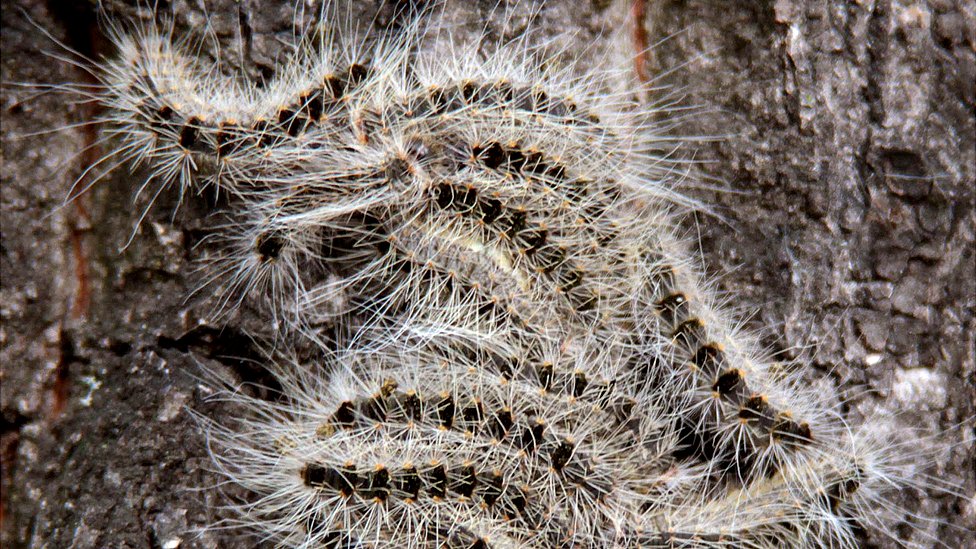The processionary caterpillars produce two types of damage: the first, which affects the plants, causes the loss of needles, since the caterpillars feed from the end of winter to the middle of the spring of pine and cedar needles. On the other hand, the caterpillars are strongly allergenic, being able to produce severe allergic outbreaks in people and animals, both in forest areas and in. Pine Processionary caterpillars are interesting little creatures. They go on long treks in single file lines. One day, a botanist decided to mess with them. What resulted was a strangely. The oak processionary moth is a species of moth with caterpillars that nest on oak trees. The caterpillars are covered in small hairs which can cause health risks in humans. To minimise health risks: Do not touch or approach oak processionary moth caterpillars or their nests.
The oak processionary moth (Thaumetopoea processionea, OPM) has been spreading into the north for years. One of the main reasons is the decline in late frosts, since the moth thrives in warmer temperatures. The oak processionary moth therefore inhabits the warmer regions of Germany, especially Brandenburg, Berlin, North-Rhine Westphalia, Baden-Württemberg and Franconia. 247 slots halloween.

The pests eat the buds and leaves of oaks. The trees are mostly located on the sunny edges of forests, but also in gardens, outdoor pools and sports fields.
Toxins on the hairs
The oak processionary moth itself is harmless. But the caterpillar’s irritating hairs can cause problems. They are barbed and very fine, with a diameter of 0.2 mm. Thaumetopoein, a protein on the surface of the hairs, is particularly hazardous to human heath. Normally, this toxin protects the caterpillar against its natural predators.
Processionary Caterpillar Rash

The irritating hairs are very brittle and fall off at the slightest touch. Then they either remain in the spun nests of the oak processionary moth or are transported by the wind, sometimes over long distances.
Avoid risk areas

The pests eat the buds and leaves of oaks. The trees are mostly located on the sunny edges of forests, but also in gardens, outdoor pools and sports fields.
Toxins on the hairs
The oak processionary moth itself is harmless. But the caterpillar’s irritating hairs can cause problems. They are barbed and very fine, with a diameter of 0.2 mm. Thaumetopoein, a protein on the surface of the hairs, is particularly hazardous to human heath. Normally, this toxin protects the caterpillar against its natural predators.
Processionary Caterpillar Rash
The irritating hairs are very brittle and fall off at the slightest touch. Then they either remain in the spun nests of the oak processionary moth or are transported by the wind, sometimes over long distances.
Avoid risk areas
“When hiking in the summer, it is very important to avoid areas where the oak processionary moth is present – well into the autumn”, says ECARF expert Torsten Zuberbier, head of allergy research at Charité in Berlin. The irritating hairs can remain in the nests in trees for years and cause unpleasant symptoms. And beware: Even pets can bring the hairs back into the home.
If you find nests in your own garden, you should call the experts. Which pa casinos are closed. If the nests are improperly removed – by torching them, for example – the irritating hairs can be dispersed over hundreds of metres.
Rash or allergy
When the skin is exposed to the irritating hairs, the initial reaction is burning and severe itching. Then small red nodules appear, which remain for several days. ”It looks as if the skin has been bitten by many insects”, explains Zuberbier.
Breathing in the hairs can irritate the upper respiratory tract, which can lead to shortness of breath in people with pre-existing conditions. If the hairs are swallowed, the mucous membranes in the throat can swell and become inflamed.
“However, serious skin and respiratory tract allergies can also occur”, warns Zuberbier. Even anaphylactic reactions, including anaphylactic shock, have been known to occur.
What should you do immediately after exposure?
“If you enter an affected area by accident, you should get rid of the hairs as quickly as possible – by showering, washing your hair and washing your clothes thoroughly”, says Zuberbier. Otherwise the hairs will get under your clothes and the itching will continue.
In addition, any objects that you were using when you came in contact with the hairs should be carefully cleaned – including the car you drove to the forest – inside and out.
What if you have papules?
Pine Processionary
If papules have appeared, dermatological treatment is recommended, usually with hydrocortisone cream, which offers fast relief of symptoms. “It is completely safe to use this cream for brief periods of a few days”, says Zuberbier. Side effects only occur if the creams are used in long-term treatments.
What if you have an allergic reaction?
If you have an allergic reaction, including asthma symptoms or pronounced skin problems, you should consult a doctor immediately. You will be prescribed an allergy medicine, such as asthma sprays, antihistamines or cortisone tablets.
Date: 29 July 2020
Sources
Rahlenbeck S and Utikal J.Buses W et al. Eichenprozessionsspinner-Allergie: Raupen mit reizenden Brennhaaren (Oak processionary moth allergy: caterpillars with irritating hairs) Dt. Ärzteblatt 2017; 114 (18): 896-8 (In German)
Julius Kühn Institute, Institute for Plant Protection in Horticulture and Forestry
Processionary Moth Caterpillar
Last retrieved on: 28 July 2020 (In German)
Processionary Caterpillars
Lower Saxony Ministry of Social Affairs, Health and Equality
(April 2014) updated July 2019
Last retrieved on: 28 July 2020 (In German)
The Processionary Caterpillar is so called, because of their characteristic marching nose to tail in a procession.
According to information from locals and what we have read, the Pine Processionary Caterpillar (Thaumetopoea Pityocampa) is a nasty piece of work. The hairs on the caterpillar have tiny barbed hairs containing a protein called thaumetopoein, which is highly irritating to the skin. Contact with the hairs of the caterpillar can cause severe rashes and eye irritation.
Dogs are generally worst affected as they may be inquisitive and sniff them, or they may pick up the hairs on their paws, which they are prone to lick because of the irritation and hence spread the poison to their mouth.
Dogs may suffer breathing difficulties and vomiting as a result. Urgent veterinary treatment should be sought. Sometimes amputation of the nose or tongue may be required. If the throat is affected, suffocation and death may result.
As we have two dogs, we are obviously very concerned by this. We have seen hundreds, if not thousands of caterpillars, which look very similar (see photo above) to the Processionary Caterpillar. They are everywhere, in the olive groves and even in our courtyard. We have not seen them marching in processionary style, and there is a lack of pines here, but they look very similar. We have sent some photos off to experts for identification.
I shall update this post when I get a reply. In the meantime, we try to be very careful with our dogs, but it’s not easy!
Update 26 March 2018
Reassuring to hear, but we’re playing safe, just in case and doing our best to keep our dogs away from them.

